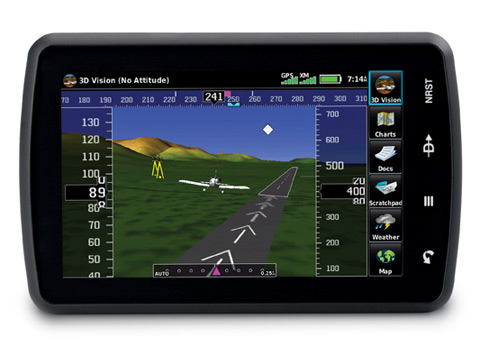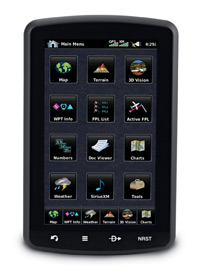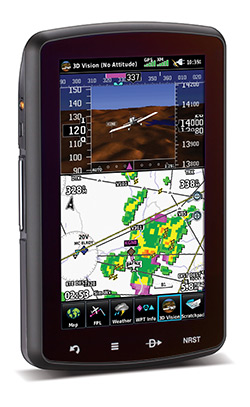Avionics: Garmin’s tablet solution
“3D Vision” in a portable GPS
It doesn’t surf the net, take pictures, or enable video chat. But Garmin’s new aera 796 brings iPad-like features to a dedicated aviation GPS that include geo-referenced charts, a bright “pinch-zoom” screen that shows in both vertical or horizontal modes, and innovative 3D Vision that brings GPS-derived synthetic vision to a portable unit.
“We believe very strongly that there’s a market for a dedicated aviation GPS,” said Jim Alpiser, Garmin director of aftermarket sales. “The 796 has some features in common with the iPad, but it’s meant for aviation and aviation only, and it will thrive in harsh cockpit environments where the iPad and other tablet computers can’t and don’t.”

The retail price for a 796 is $2,499 (or $2,199 for a 795, which lacks XM Weather capability), and was publicly unveiled at AOPA Summit in Hartford, Connecticut.
Garmin’s 3D Vision builds on the company’s pioneering Synthetic Vision Technology (SVT) by offering a symbolic exterior view of the pilot’s own airplane as it moves over and around the surrounding terrain. The pilot can change the viewing angle if desired, but an in-trail perspective looking slightly down at the symbolic airplane (a highly realistic RV–6 with a spinning propeller) provides a view that’s easy to interpret and shows terrain in vivid detail.
Mountains, valleys, rivers, airports, and obstacles show up in color-coded clarity, and groundspeed is displayed on the left side of the screen, altitude on the right, and magnetic heading across the top. There are no “pathways” or highway-in-the-sky rectangular boxes that appear on Garmin G1000 primary flight displays. Instead, a tiny, triangular magenta course deviation indicator at the bottom of the 796 screen shows whether the pilot is left or right of the desired course.
Since the 796 isn’t connected to an onboard Attitude Heading Reference System (AHRS), it’s incapable of providing primary flight data such as aircraft pitch attitude, indicated airspeed, or barometric altitude. Instead, it operates much like a turn coordinator by sensing the rate of heading change and estimating the bank angle, all the while graphically depicting the symbolic airplane in its geographic surroundings.
Like SVT, 3D Vision is especially comforting on IFR approaches when the airport appears as it would on a clear day, even when the facility itself isn’t in view.
 The touch screen and icons draw much from tablet computers, which have become such fierce competitors.
The touch screen and icons draw much from tablet computers, which have become such fierce competitors.
The 796 gives pilots the ability to customize the touch-screen keyboard in the way they prefer (QWERTY or alphanumeric). Switching between portrait and landscape views requires pressing a sequence of icons since there are no internal accelerometers as on an iPad.
The list price for a new 796 is three times as much as that of an iPad, and $1,100 less than the GPSMAP696—the original “MFD on your knee” that Garmin introduced in 2008 and will continue to support. (The company also lowered the price of a new 696 to $2,199.)
A subscription to geo-referenced FliteCharts for the 796 is $199 a year, and a database bundle that includes all charts and navigation data is $499. Garmin’s SafeTaxi system and AOPA Airport Directory are included at no additional charge.
Updated data can be downloaded to the 796 via SD card.
The 796 has the same seven-inch (diagonal) screen as the 696 and identical resolution and pixel count, but a narrower, lighter frame with no external knobs or buttons. Battery life has been extended to three hours at full brightness with the XM receiver attached compared to two hours for the 696.
The 796 also offers a “scratchpad” screen that pilots can use to write clearances Etch-a-Sketch-style by dragging a fingertip. No pen, pencil, or stylus is needed or desired (although my own fat-fingered scrawling could be nearly impossible to decipher). A separate document viewer allows downloading aircraft manuals and checklists.
The 796 uses a capacitive screen like Garmin’s panel-mount GTN750 and 650 that sense electrical charges from the user’s finger. A resistive screen such as the kind found on the aera 500-series senses pressure instead of electrical current. Pilots who fly with gloves may elect to cut off the tip on the index finger of the glove they wear on the GPS hand in order for the 796 to work properly.
Pilots accustomed to other Garmin products will find the shallow menus with familiar icons easy to navigate. The home page can be reached by simply holding down the dedicated Back key, and it’s seldom more than two touches away.
Flight plans are easy to build and modify in flight, and loading approaches becomes quick with practice. But some practice, or at least reading the 46-page Quick Reference Guide (QRG), is in order. (Don’t be put off by the long length of the QRG. Much of it is lawyerly admonishments that no one reads, and the rest is extremely concise and well illustrated.)
Four permanent keys at the bottom of the 796 provide the most commonly used commands: back, menu, direct-to, and nearest. There’s also a panel page on the moving map (familiar to users of the 496, 696, and aera series) that shows steam-gauge-style presentations for groundspeed, altitude, HSI, vertical speed, and turn coordinator. Unlike the 696, however, which allows users to switch instantly between the panel and full-screen map views at the touch of a single button, performing the task on a 796 requires several steps.
Airspace questions can usually be answered by touching the Class B, C, or D rings or MOA markings and reading the information provided about floors, ceilings, and radio frequencies for controlling agencies. Touch a mountain on the map and the 796 shows its height in msl.
 The 796 screen is bigger and brighter than many panel-mounted GPS navigators.
The 796 screen is bigger and brighter than many panel-mounted GPS navigators.
The 796 offers pilots their choice between Garmin’s own moving map (with weather, terrain, and topographical overlays) and photocopied VFR sectionals and IFR low- and high-altitude charts. But the VFR and IFR charts have one big limitation in that they can’t overlay the magenta course line or XM Weather.
Personally, I prefer the clarity and better readability of Garmin’s own hybrid maps, but many pilots have been clamoring for actual charts, and the 796 gives them what they’ve been asking for. Garmin also performs a neat sleight-of-hand trick by seamlessly switching between VFR sectionals and more detailed terminal area charts as the user zooms in on cities with the nation’s busiest airports. (Watch carefully, though, because the change is so quick it’s easy to miss.)
Garmin is mum on ways that it might upgrade the 796 in the future—but the new device lays the hardware foundation for ADS-B “In” features such as subscription-free cockpit weather and traffic that are at the core of the “NextGen” air traffic control system. And 3D Vision invites speculation about ways in which the 796 might become connected to a future AHRS so that it can provide primary flight data (as Garmin’s own G3X does in the Experimental market).
The 796 is unlikely to win over 696 owners, many of whom have hard-wired the versatile MFDs into their panels. But the 796 isn’t intended for them so much as iPad users. It aims squarely at the ubiquitous tablet by adopting some of its best features and packaging them in a sturdy, robust frame, with a screen that absorbs glare and is much easier to read in direct sunlight.
In some ways, the 796 assumes pilots already have another tablet computer or smartphone since the 796 borrows much from those devices. Also, since the 796 isn’t linked to the Internet, those other devices are still helpful for preflight tasks such as checking weather and filing flight plans remotely.
Garmin is betting that pilots, even those among us already enamored with the iPad, will want a 796 in their flight bags, too.
Email the author at [email protected].


